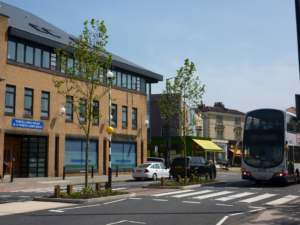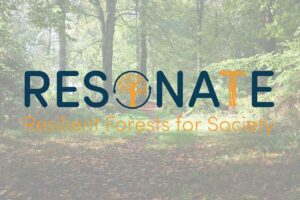Chartered Forester Russell Horsey MICFor, Director at Goetre Villa Ltd, highlights how urban trees help make our towns and cities a cleaner place.
As cities across the world look to tackle air pollution car free zones, congestion charging and the use of electric vehicles have all been proposed. In London there is now a suggestion that the city also becomes a “national city park” and today on national clean air day there will no doubt be a myriad of blogs about the need to get give up your car in an attempt to cut air pollution.
 Urban trees have a significant part to play in helping make our towns and cities cleaner places to live, work and play. Urban Trees have been shown to improve air quality and reduce local particulate matter between 7 and 24%(1)(2)urban trees cool local air by up to 2 degrees which reduces building cooling energy requirements up to 300 metres from tree plantings(2). The bigger the final tree size the more direct pollution it can remove and the closer the tree to the pollution the better it is at removing pollution with the best results occurring with 30m of a tree(2). This is why cities like New York are investing so much money and effort on their million trees campaign which sees 300,000 new street trees being planted.
Urban trees have a significant part to play in helping make our towns and cities cleaner places to live, work and play. Urban Trees have been shown to improve air quality and reduce local particulate matter between 7 and 24%(1)(2)urban trees cool local air by up to 2 degrees which reduces building cooling energy requirements up to 300 metres from tree plantings(2). The bigger the final tree size the more direct pollution it can remove and the closer the tree to the pollution the better it is at removing pollution with the best results occurring with 30m of a tree(2). This is why cities like New York are investing so much money and effort on their million trees campaign which sees 300,000 new street trees being planted.
New York – A street planted as part of the Million Trees New York Project
A recent research paper looking at Toronto in the Journal of Nature showed that having 10 more trees in a city block improves peoples heath perception and many papers have looked at the restorative health benefits nature provides.(3) This has lead the US Environmental Protection Agency to introduce urban tree cover as an emerging measure to help meet air quality standards, will we see something similar in the UK with the appointment of Sir William Worsley as the UK’s first Tree Champion?
In UK cities we are seeing different approaches, Sheffield Council has just launched a marketing campaign to persuade drivers to give up their cars but at the same time fails to recognise the benefits of their existing street tree stock as it looks to fell an estimated 10,000 street trees although this could rise to 17,500 street trees during the remaining 20 years of its Streets Ahead Project.
Meanwhile Bristol recently launched “Lets Talk Trees” a campaign that aims to double the cities canopy cover by 2050 in order to combat air pollution and enhance Bristol’s urban environment. The latter is interesting as it picks up on the results of work done through investment in the Greater Bristol Bus Network (GBBN).
GBBN took a holistic approach to transport corridors across the city improving street furniture, signal operation, access to local shops, public realm improvements, planting hundreds of new trees along routes, improving bus lanes and the introduction of newer buses. GBBN has since become a Department for Transport showcase as well as winning numerous design awards. Bus usage, cycle usage and bus user satisfaction targets were met and exceeded, bus punctuality and air quality along routes improved and exceeded targets, road safety also improved for all users (4).
 Whiteladies Road, Bristol – Newly Installed Central Reserve Tree Planting
Whiteladies Road, Bristol – Newly Installed Central Reserve Tree Planting
A Chinese proverb suggests that “the best time to plant a tree was 20 years ago and the second best time is now”, but location and final size are important if we are to improve air quality. Individually trees can help remove pollution at source but more importantly adding trees and improving public realm along bus corridors is also a significant factor in getting people out of their cars and onto buses or bikes. Failure to look at all these elements and focus on one element will likely result in failure to change people’s habits and improve air quality.
References:
- Nowak D.J, Crane D E & Stevens J.C (2006). Air Pollution removal by urban trees and shrubs in the United States. Urban forestry and Greening.
- The Nature Conservancy (2016). Planting Healthy Air, A global analysis of the role urban trees in addressing particulate matter pollution and extreme heat.
- Kardan O, Gozdyra P, Misic B, Moola F, Palmer LJ, Paus T & Berman M (2015). Neighbourhood greenspace and health in a large urban centre. Ww.Nature.com/scientificreports.
- The West of England Partnership (2014). Greater Bristol Bus Network Monitoring Report.
Disclaimer: The views and opinions expressed in this article are those of the author and do not necessarily reflect the views of the Institute of Chartered Foresters.






